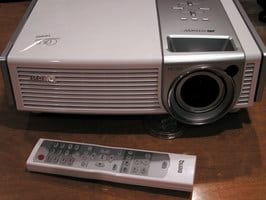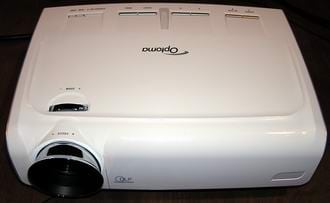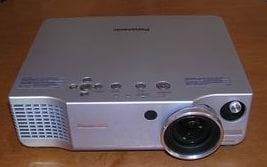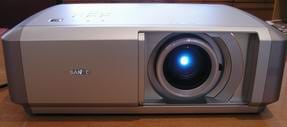The the world of more expensive home theater projectors, - over $4000, is dominated by DLP projectors, which at that price range and above are generally considered to produce a better image than LCD, and have a more "film-like" quality. However, in the $2000 range, LCD and DLP are generally considered comparable, each technology, with its own distinct advantages.
The InFocus has been included in this list, as InFocus is a top selling brand of home theater projectors, and their new model is almost certainly to be a significant competitor. At this time we are not sure as to the selling price, so it may not be price competitive. Nor can we comment on how good the IN76 is, but want readers to know that they may want to take that projector into consideration, if comparably priced... This article will be updated after we complete the InFocus review. In this article, two other, more expensive projectors are also mentioned. They are more in the $2500 plus range, but may fit your needs if you have a larger budget.
All projectors are widescreen (16:9) aspect ratio, HDTV compatible, with a native resolution of 1280x720 (actually, one, the Optoma HD72 is 1280x768) - which means true hi-def. Yes there is a second, higher resolution HD: 1920x1080. To date, only a few if these 1080p projector are on the market, and right now, they start around
$10,000 and up.
The image to the right is the Panasonic PT-AE900U.
Price catagories reflect typical discounted online selling prices. Expect higher prices in "local" dealers that offer installation.
Under $2000 Home Theater Projectors: (listed in order of review date - oldest to newest) The links below will take you to the full length reviews.
Of this list of 5 home theater projectors, the Sanyo PLV-Z4 and the Panasonic PT-AE900u are the two LCD projectors, and also happen to be the two least expensive. The other three are all DLP projectors.
To the right is an image of the BenQ PE7700.
I should mention that there are two others that are both LCD projectors - Epson's Cinema 550 and Sony's HS-51A. Both are also reviewed, but too expensive for this comparison.
If your budget runs to $2500 or perhaps more, you may also want to visit the www.projectorreviews.com website and read about them. I point out below where they might have an advantage to you if you have the budget.
Each of these projectors has won a Hot Product Award. Each has strengths and weaknesses compared to each of the others, and I'm pretty confident that each one has a significant potential customer base for which that projector is the best choice.
For this short article, these are the areas of comparsion:
- Brightness
- Image Quality (Color accuracy, black levels, contrast and shadow detail)
- Sharpness
- Ergonomics (flexibility in placing in your room...)
Brightness
All of these home theater projectors are designed to work in fully darkened, or very dark rooms, for viewing movies. They all have brighter modes to handle more ambient light, especially handy for watching content where a dark room is not ideal, such as sports, or most regular TV, or gaming.
In the world of brightness, if you need a lot, of all these projectors, the new Optoma HD72, is definitely the brightest in its best movie mode, and also in its brightest mode.
The BenQ PE7700 (a DLP projector) and the Panasonic PT-AE900u are next with the BenQ having a slight edge, but both are significantly less bright than the Optoma. Last comes the Sanyo PLV-Z4. The verdict is out in the InFocus IN76 since we won't have one for testing for a couple more weeks.
In a proper room any of these projectors will do a good job with a 92" to 110" diagonal screen, but the Sanyo will be the most tested. The Optoma can handle a 128" screen with no problem at all.
If you need one of the brightest projectors, but the Optoma won't work in your room, consider the Epson Cinema 550 - its more money, but also very bright, and as an LCD projector, it has more placement flexibility.
Image Quality:
Color Accuracy: Out of the box. If you just want a home theater projector you can unbox, plug in, and not have to adjust colors, etc, to maximize the image quality, the Panasonic PT-AE900u does the best job in handling flesh tones, and general colors "right out of the box".
Quicktip: All of the projectors can use a good, quick calibration. A $49 list price calibration disk like AVIA's Guide to Home Theater, is all you need, plus a little patience, and about 60 minutes. (No, you do not have to be technically savvy, just follow simple instructions.). I strongly recommend getting one.
Next best out of the box color (virtually as good) belongs to the BenQ PE-7700.
The others definitely need that calibration to give you what I would call good quality flesh tones, and overall good color balance.
Please note, if these home theater projectors are calibrated, the difference in color accuracy between them becomes minor.
Image Quality:
Shadow details and black levels
One of the key measures of a good home theater projector, is how close it can get, to producing a true black. At best they all produce dark grays. DLP projectors normally have the advantage here, but both the Sanyo and Panasonic LCD projectors use "AI" (artificial intelligence) to compensate, frame by frame. With AI they can dim the entire projector down for a darker frame, producing "blacker blacks". (This only works if there are no really bright areas). The Sanyo, in particular, does this well, with both an adjustable iris, and a lamp that can be dimmed frame by frame. As a result it claims the best contrast ratio, but that doesn't necessarily translate into the the best blacks all the time. If a scene has areas that are at full brightness, it pretty much prevents the dimming of the lamp, or closing of the iris down if those are otherwise in use.
A few DLP projectors are now also using AI, and the HD72 from Optoma is one of them.
Overall, when it comes to black levels the Optoma HD72, and the BenQ have a slight advantage, but with AI engaged, on the right scenes, the Panasonic and Sanyo are definitely comparable, and on certain scenes, the Sanyo will significantly reduce black levels. In should note, that Sony's HS51A also uses AI and does the best job on blacks of any of the LCD projectors.
Image Quality
Screen Door and Rainbow Effects, and Seating Distances:
Each technology has a weakness. DLP home theater projectors rely on a color spinning wheel to generate colors, and a small percentage of people will notice this, as the "rainbow effect" seeing, perhaps, and occasional flash of red green blue. Today's DLP projectors mostly use 4 times or 5 times normal speed color wheels which eliminates the "rainbow" problem for all but a very few. The BenQ uses a 5X wheel, while the Optoma uses a 4X wheel. Some lower cost DLP projectors still use 2X wheels.
As a result, a very few of you may find that a DLP projector won't work for you.
Now, moving to LCD home theater projectors, they have more visible pixels, and that leads to an effect called the screen door effect. Sit too close and you see a distortion from patterns of pixels conflicting with patterns in the image - like looking through a screen door. The screen door effect on grass in a ballpark would be a very noticeable example if you sit too close. How close is too close? Typically, closer than 1.3-1.5 times the screen's width, for most LCD projectors.
A 110" diagonal screen is about 96" wide, so you might find screen door to be visible if you are sitting closer than 11 feet away.
The Sanyo Z4 is typical (for an LCD projector) in terms of screen door effect. By comparison, the Panasonic PTAE900u uses "Smooth Screen" LCD's and it's pixels are only about as visible as a DLP projector's. As a result, the Panasonic really does not have a real issue with screen door effect, and that is a plus, compared to the Sanyo.
One more note. Today's DVD's are no where near as hi resolution as HDTV. Today, that means that sitting close enough to your screen to see the screen door effect on a DLP projector, (or the Panasonic PTAE900u), means sitting close enough that the image is very soft from lack of resolution. With next generation DVD's coming soon - Blu-Ray and HD-DVD - , (they will offer least the same 1280x720 resolution as these projectors - 2.25 times more resolution than today's 854x480 resolution DVDs), they will be sufficiently sharp. This will allow more people to chose to sit in the equivilent of the front half of the theater and still have a sharp image. For those folks, who like sitting close, the screen door effect is a real issue.
Bottom line here, the Sanyo Z4 requires sitting a bit further back than the other three projectors. However, in fairness, most people prefer to sit in the area where the Sanyo is just fine. We'll have to see how the InFocus IN76 performs before we can say if it behaves more like the Sanyo, or the others.
Image Quality - Sharpness
In this catagory, Sanyo's home theater projector has a slight edge, especially on DVD, compared to the other projectors. This is likely to to the scaling process of taking a DVD's 854x480 resolution up to 1280x720 of the projector. The Sanyo does this particularly well. The Sanyo though is also at least as sharp as the others on Hi-Def.
Next in sharpness come the Optoma HD72, and the BenQ PE7700. The Panasonic is a little softer than the others. Of the other, more expensive projectors, the Sony HS51A comparable to the Sanyo, while by comparison, the Epson is softer than the Panasonic on DVD.
Ergonomics
Generally, LCD projectors have a big advantage in this regard. Both the Sanyo and Panasonic home theater projectors, offer 2:1 ratio zoom lenses. In most rooms, that means you can place the projector somewhere between halfway back all the way to the back wall. This also means that you can shelf mount the projector instead of putting it on a table, or ceiling mounting it. (Note, the Epson and Sony LCD projectors also have wide range zooms, not as much as these two, but more than the DLP projectors.
The other advantage of LCD projectors in this price range, is lens shift, which allows you placement flexibility in terms of height. Combine the zoom lens and lens shift and rear wall mounting works almost every time. The Sanyo has a slight edge over the Panasonic in lens shift. You can place the projector from about a foot or so (depending on screen size) below the bottom of the screen, to an equal amount above the top.
Switching to the two DLP projectors, they both offer zoom lenses with only 1.2:1 zooms - a shift of 20% not the 100% of the Panny and Sanyo. This means that with a 110" screen, you have about 2+ feet of placement flexibility.
In addition they both lack lens shift, which typically doesn't show up in DLP projectors selling for less than $3000-$4000
With the BenQ PE7700 home theater projector, if you place the projector on a low table or low wall shelf, the center of the lens needs to be exactly even with the bottom of the screen surface. If ceiling mounting, even with the top of the screen surface.
The Optoma, by comparison, sits lower on a table or back shelf, probably about 1 good foot below the bottom of screen surface, or an equal amount above the top when ceiling mounted.
So, bottom line on ergonomics - the Panny and Sanyo have a major edge in where you can place them.
Summary
Each of these four home theater projectors have particular strengths and weaknesses. The good news is that all of them produce an image that almost certainly will perform better than you had anticipated!
Before making your final decision on purchasing a home theater projector in this range, I suggest you read the full reviews of the projectors that look like they will work for you.
I strongly recommend that you choose your dealer wisely. Find one with a good buy policy (it can't hurt), and one that is knowledgeable. You might end up spending an extra $100 or more, but it can be a really good investment.
Two more tips: Buy high quality cables, for, you can see the difference. Screens are the other key area, match the screen to your projector's traits and to your room.
Here's a couple of lines on each of the four review projectors pointing out their relative strengths and weaknesses.
Panasonic PT-AE900u: Good brightness, best out of the box color, "Smooth Screen" lcd panels make it less suspectable to screen door effect. Great room placement abilities. On the down side, average brightness, and an image not quite as sharp as the others. 1 year warranty.
Sanyo PLV-Z4: Least bright of the four, needs basic calibration for colors. It also offers the best room placement flexibility, and has an xceptionally sharp image. Weakest on handling regular (non-HD) TV, and requires the furthest seating distance in terms of avoiding screen door effect. Three year warranty.
BenQ PE7700: Good Brightness, very good "out of the box" color, very good black levels and shadow detail, sharp image. Very "film like". Very well balanced colors in brightest mode. Very limited room placement flexibility. Three year warranty. Slightly more expensive than the Sanyo or Panasonic projectors. Three year warranty.
Optoma HD72: By far the brightest. Best picture in best mode (after color calibration), with very rich colors. "Brilliant Color" technology lets you easily adjust image quality to compensate for room and personal preferences. Very good black levels and shadow detail. Very imited placement flexibility, although long zoom throw lens probably will let you place on rear wall. Needs that basic color calibration more than the others. Two year warranty.
The image of Gandalf was shot on the Optoma HD72.
The InFocus IN76 is our unknown, so look for our review and update in a month or less.
Of the two more expensive projectors I mentioned:
 Click Image to Enlarge
Click Image to EnlargeEpson Cinema 550: Brightest of the LCD projectors and close to the Optoma HD72 in that regard. Excellent room placement (not quite as good as the Sanyo). This projector is a more expensive alternative if you need that placement flexibility AND need an especially bright projector.
Sony VPL-HS51A: The most expensive of all of these. Very sharp, and the blackest blacks of all. Pricing, though, is typically at least a $1000 more than the Sanyo or Panasonic. The Sony, like the Sanyo, is not particularly bright.
Summary: Personal preferences are going to be a key determining factor, unfortunately very few people shopping for projectors in this class will get to actually see one or more of them, let alone side by side. For my money, I lean toward the Optoma overall, for its picture, and brightness, if the room issues work out. I can tell you that I have recommended at least once each of these four projectors, to people I know, based on their individual requirements.
Take your time, and choose wisely. Again, all of these award winning home theater projectors will produce a truly impressive image for their rather reasonable prices. -art






